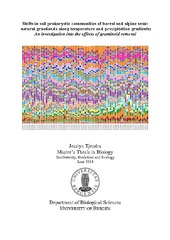Shifts in soil prokaryotic communities of boreal and alpine semi-natural grasslands along temperature and precipitation gradients: An investigation into the effects of graminoid removal
Master thesis
Permanent lenke
https://hdl.handle.net/1956/17849Utgivelsesdato
2018-06-27Metadata
Vis full innførselSamlinger
Sammendrag
Biotic interactions are important drivers of ecological responses to climate change. By studying the effects of graminoid removal on forb populations along temperature and precipitation gradients, Olsen et al. (2016) found that temperature increase shifted the net outcome of plant interactions from facilitation to competition in the boreal and alpine semi-natural grassland ecosystems. The study thus raised the concern that graminoids, the dominant plant functional group in these ecosystems, would further outcompete the subordinate groups such as the forbs as the climate continues to warm up. This Master´s thesis project was an extension to the study, digging deeper into the experimental set-up to investigate how soil prokaryotes had responded to five years of the graminoid removal. The results showed no significant change to the overall community composition, nor the diversity (number of observed OTUs, Chao1, Shannon H’ and Simpson’s E), of the soil prokaryotes due to the removal. This could be interpreted as a positive outcome, as the results casted doubt over the likelihood of impact of the reverse scenario – increased graminoid dominance – on soil prokaryotic communities under a warmer climate. While graminoid removal yielded no detectable response, the overall community composition was found to vary significantly along both the temperature and precipitation gradients. Redundancy analysis on the community composition data further revealed that the two climate variables combined explained 20.5% of the variation in the data, with 11.1% and 9.34% of the variation attributed to precipitation and temperature, respectively. Relative abundance of the K-selected acidobacteria increased with increasing temperature and precipitation, while the r-selected proteobacteria decreased in relative abundance as the temperature rose. This change in the ratio of the two dominant soil bacterial phyla was indicative of a shift towards a more competitive environment for the prokaryotes as temperature increased – just as it was for the plants. All in all, the soil prokaryotic community in these boreal and alpine semi-natural grasslands demonstrated a considerable level of ecological resilience to natural and anthropogenic environmental changes. Such resilience provided some consolation in the face of climate change impacts.
